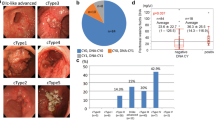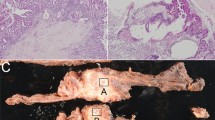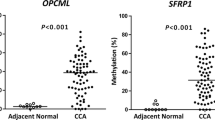Abstract
Purpose
To assess whether gene methylation in peritoneal fluid (PF) is clinically feasible for determining micrometastasis to the peritoneum in gastric cancer.
Methods
The gene methylation of BNIP3, CHFR, CYP1B1, MINT25, SFRP2, and RASSF2 were analyzed in 107 specimens of PF by quantitative methylation-specific polymerase chain reaction. All patients were placed into one of 3 groups: group A (n = 42), patients with depth of cancer invasion at muscularis propria (MP) or less than MP; group B (n = 45), depth of cancer invasion beyond the MP; and group C (n = 20), histologically diagnosed peritoneal metastasis or cancer cells cytologically defined in the peritoneal cavity. Patients in both groups A and B were diagnosed as having no cancer cells by peritoneal cytology and histology.
Results
The methylation status of the 6 genes was found to be significantly different among the 3 groups (group A, 0–5%; group B, 0–15%; group C, 15–45%; P < 0.01). Furthermore, the rate of positive methylation in any of the 6 genes was significantly different in each group (group A, 7%; group B, 20%; group C, 75%; P < 0.001). Three of 9 patients in group B with positive methylation in any of 6 genes experienced peritoneal recurrence. On the other hand, only 1 of 36 patients without gene methylation experienced peritoneal recurrence (P < 0.05).
Conclusions
DNA methylation in PFs is a possible marker detecting occult neoplastic cells on the peritoneum. Methylation analysis along with a cytological examination might therefore improve the positive detection of cancer cells in PF of gastric cancer.

Similar content being viewed by others
References
Yoo CH, Noh SH, Shin DW, Choi SH, Min JS. Recurrence following curative resection for gastric carcinoma. Br J Surg. 2000;87:236–42.
Fujiwara Y, Doki Y, Taniguchi H, et al. Genetic detection of free cancer cells in the peritoneal cavity of the patient with gastric cancer: present status and future perspectives. Gastric Cancer. 2007;10:197–204.
Lee CC, Lo SS, Wu CW, et al. Peritoneal recurrence of gastric adenocarcinoma after curative resection. Hepatogastroenterology. 2003;50:1720–2.
Mori K, Suzuki T, Uozaki H, et al. Detection of minimal gastric cancer cells in peritoneal washings by focused microarray analysis with multiple markers: clinical implications. Ann Surg Oncol. 2007;14:1694–702.
Yamamoto M, Baba H, Toh Y, Okamura T, Maehara Y. Peritoneal lavage CEA/CA125 is a prognostic factor for gastric cancer patients. J Cancer Res Clin Oncol. 2007;133:471–6.
Da MX, Wu XT, Guo TK, et al. Clinical significance of telomerase activity in peritoneal lavage fluid from patients with gastric cancer and its relationship with cellular proliferation. World J Gastroenterol. 2007;13:3122–7.
Hiraki M, Kitajima Y, Sato S, et al. Aberrant gene methylation in the peritoneal fluid is a risk factor predicting peritoneal recurrence in gastric cancer. World J Gastroenterol. 2010;16:330–8.
Okami J, Simeone DM, Logsdon CD. Silencing of the hypoxia-inducible cell death protein BNIP3 in pancreatic cancer. Cancer Res. 2004;64:5338–46.
Wang X, Lau KK, So LK, Lam YW. CHD5 is down-regulated through promoter hypermethylation in gastric cancer. J Biomed Sci. 2009;16:95.
Hiraki M, Kitajima Y, Sato S, et al. Aberrant gene methylation in the lymph nodes provides a possible marker for diagnosing micrometastasis in gastric cancer. Ann Surg Oncol. 2010;17:1177–86.
Kang GH, Lee S, Cho NY, et al. DNA methylation profiles of gastric carcinoma characterized by quantitative DNA methylation analysis. Lab Invest. 2008;88:161–70.
Wu CS, Lu YJ, Li HP, et al. Glutamate receptor, ionotropic, kainate 2 silencing by DNA hypermethylation possesses tumor suppressor function in gastric cancer. Int J Cancer. 2010;126:2542–52.
Watanabe Y, Kim HS, Castoro RJ, et al. Sensitive and specific detection of early gastric cancer with DNA methylation analysis of gastric washes. Gastroenterology. 2009;136:2149–58.
Du P, Ye HR, Gao J, et al. Methylation of PTCH1a gene in a subset of gastric cancers. World J Gastroenterol. 2009;15:3799–806.
Nagasaka T, Tanaka N, Cullings HM, et al. Analysis of fecal DNA methylation to detect gastrointestinal neoplasia. J Natl Cancer Inst. 2009;101:1244–58.
Japanese Gastric Cancer A. Japanese classification of gastric carcinoma—2nd English edition. Gastric Cancer. 1998;1:10–24.
Eads CA, Danenberg KD, Kawakami K, et al. MethyLight: a high-throughput assay to measure DNA methylation. Nucleic Acids Res. 2000;28:E32.
Carvalho AL, Jeronimo C, Kim MM, et al. Evaluation of promoter hypermethylation detection in body fluids as a screening/diagnosis tool for head and neck squamous cell carcinoma. Clin Cancer Res. 2008;14:97–107.
Katayama H, Hiraki A, Aoe K, et al. Aberrant promoter methylation in pleural fluid DNA for diagnosis of malignant pleural effusion. Int J Cancer. 2007;120:2191–5.
Fackler MJ, Malone K, Zhang Z, et al. Quantitative multiplex methylation-specific PCR analysis doubles detection of tumor cells in breast ductal fluid. Clin Cancer Res. 2006;12:3306–10.
Ibanez de Caceres I, Battagli C, Esteller M, et al. Tumor cell-specific BRCA1 and RASSF1A hypermethylation in serum, plasma, and peritoneal fluid from ovarian cancer patients. Cancer Res. 2004;64:6476–81.
Klump B, Hsieh CJ, Dette S, et al. Promoter methylation of INK4a/ARF as detected in bile-significance for the differential diagnosis in biliary disease. Clin Cancer Res. 2003;9:1773–8.
Matsubayashi H, Canto M, Sato N, et al. DNA methylation alterations in the pancreatic juice of patients with suspected pancreatic disease. Cancer Res. 2006;66:1208–17.
Roupret M, Hupertan V, Yates DR, et al. Molecular detection of localized prostate cancer using quantitative methylation-specific PCR on urinary cells obtained following prostate massage. Clin Cancer Res. 2007;13:1720–5.
Conflict of interest
None.
Author information
Authors and Affiliations
Corresponding author
Electronic supplementary material
Below is the link to the electronic supplementary material.
Rights and permissions
About this article
Cite this article
Hiraki, M., Kitajima, Y., Koga, Y. et al. Aberrant Gene Methylation Is a Biomarker for the Detection of Cancer Cells in Peritoneal Wash Samples from Advanced Gastric Cancer Patients. Ann Surg Oncol 18, 3013–3019 (2011). https://doi.org/10.1245/s10434-011-1636-0
Received:
Published:
Issue Date:
DOI: https://doi.org/10.1245/s10434-011-1636-0




